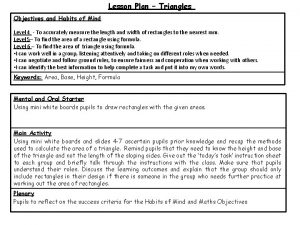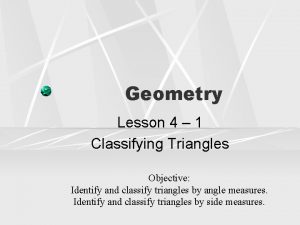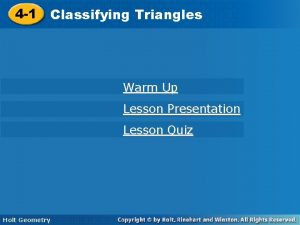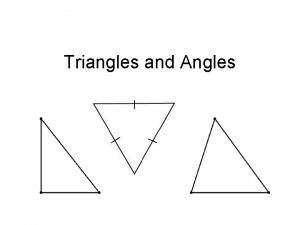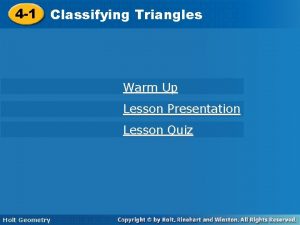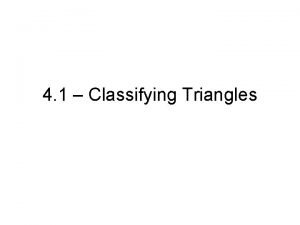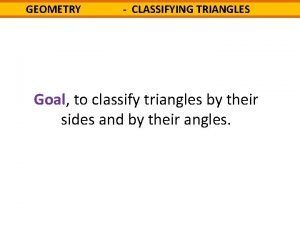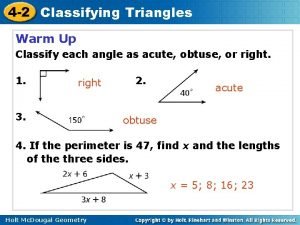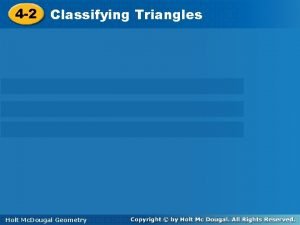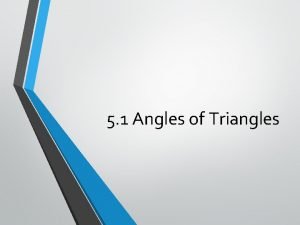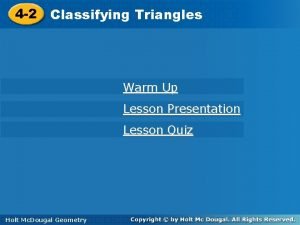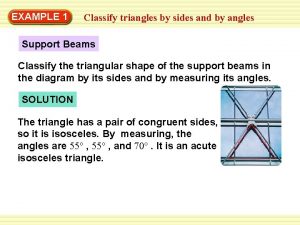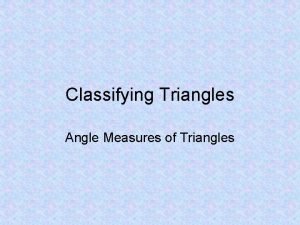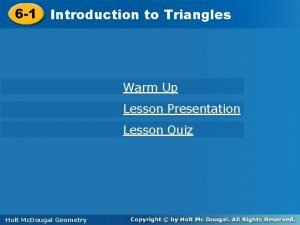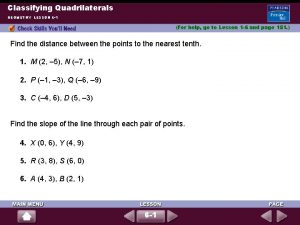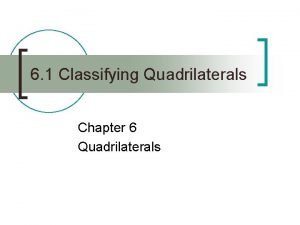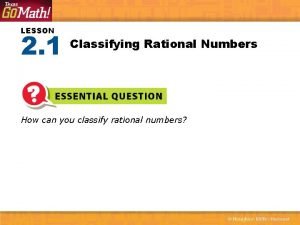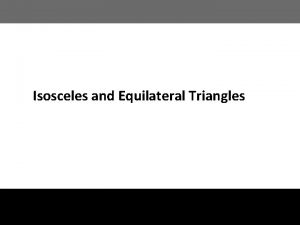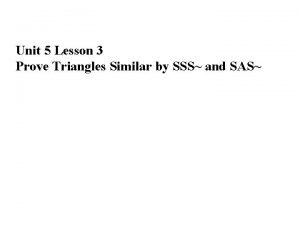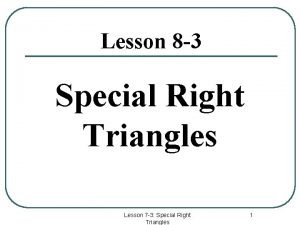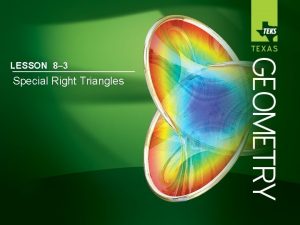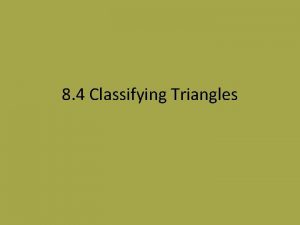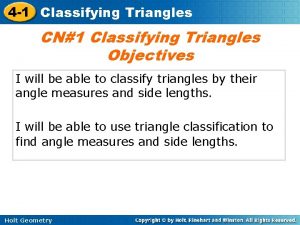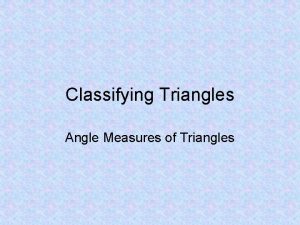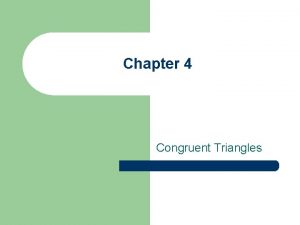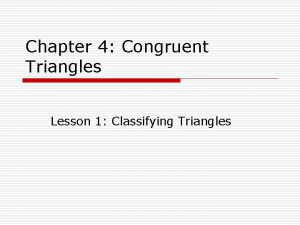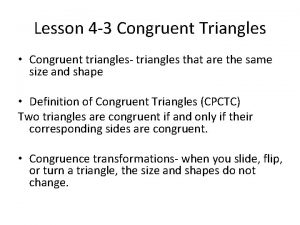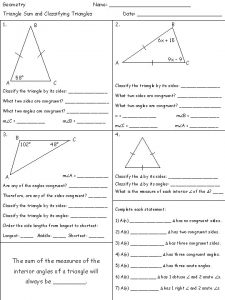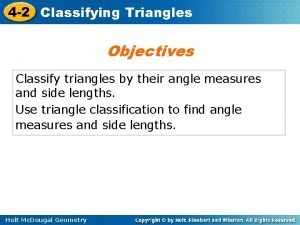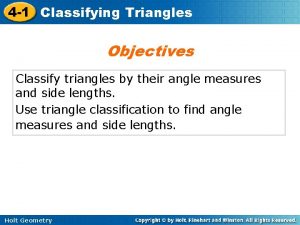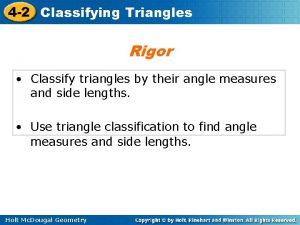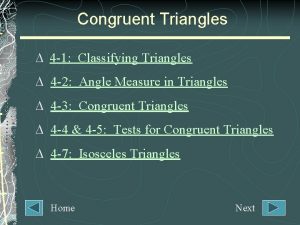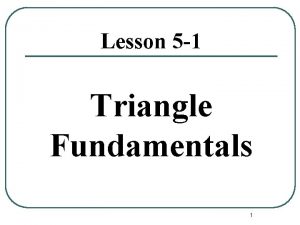Lesson 3 1 Triangle Fundamentals Classifying Triangles We

































- Slides: 33

Lesson 3 -1 Triangle Fundamentals

Classifying Triangles We name a triangle using its vertices. For example, we can call the following triangle: ∆ABC ∆BAC ∆CAB ∆ACB ∆BCA ∆CBA

Opposite Sides and Angles We say that opposite. is

Triangles can be classified by: Their sides 4 Scalene 4 Isosceles 4 Equilateral Their angles 4 Acute 4 Right 4 Obtuse 4 Equiangular

Scalene Triangle A triangle in which all 3 sides are different lengths

Isosceles Triangle A triangle in which at least 2 sides are equal

Equilateral Triangle A triangle in which all 3 sides are equal

Acute Triangle A triangle in which all 3 angles are less than 90˚

Right Triangle A triangle in which exactly one angle is 90˚

Obtuse Triangle A triangle in which exactly one angle is greater than 90˚and less than 180˚

Equiangular Triangle A triangle in which all 3 angles are the same measure

Classification of Triangles with Flow Charts and Venn Diagrams

Classification by Sides polygons Polygon triangles Triangle scalene Scalene Isosceles isosceles equilateral Equilateral

Classification by Angles Polygon polygons triangles Triangle right acute Right Obtuse Acute Equiangular equiangular obtuse

Triangle Theorems

Triangle Sum Theorem The sum of the interior angles in a triangle is 180˚.

Third Angle Corollary If two angles in one triangle are congruent to two angles in another triangle, then the third angles are congruent.

Corollary Each angle in an equiangular triangle is 60˚.

Corollary There can be at most one right or obtuse angle in a triangle.

Corollary Acute angles in a right triangle are complementary.

Exterior Angle Theorem The measure of the exterior angle of a triangle is equal to the sum of the measures of the remote interior angles.

Special Segments of Triangles

Introduction 4 There are three segments associated with triangles: 4 Medians, Altitudes and Perpendicular Bisectors

Medians 4 Definition: a segment from a vertex to the midpoint of the opposite side 4 The median is in red here.

Medians 4 How many medians does every triangle have? 4 Since there are three vertices, there are three medians. 4 Look at this example where D, E and F are the midpoints:

Altitudes 4 Definition: the perpendicular segment from a vertex to the line that contains the opposite side 4 Every triangle has three altitudes. 4 See the altitudes:

Altitudes in a right triangle 4 Two of the altitudes of a right triangle are also legs of the triangle. 4 See this example: 4 All of the altitudes are colored black.

Altitudes in an obtuse triangle 4 Two of the altitudes here must be outside of the triangle. 4 See this example: 4 The original triangle is solid blue and the altitudes are black.

Perpendicular Bisector 4 Definition: a line (or ray or segment) that is perpendicular to a segment at its midpoint. 4 The perpendicular bisector does not have to start from a vertex! 4 Every triangle has three perpendicular bisectors.

Example 1: 4 Draw the perpendicular bisector of this scalene triangle. 4 Notice how the bisector does not originate from a vertex of the triangle. in

Example 2: 4 See this example in a right triangle. 4 Draw the perpendicular bisector of this triangle. in

Special Case 4 The perpendicular bisector can pass through a vertex in an isosceles triangle (and therefore in an equilateral triangle). 4 In the isosceles triangle, when the bisector is drawn to the base, it will pass through the vertex angle point.

Isosceles Triangle 4 In , if is the base, draw the perpendicular bisector to. 4 P is the vertex of the triangle. 4 The perpendicular bisector will pass through P when drawn to the base.
 Classifying triangles lesson plan
Classifying triangles lesson plan Lesson 4-1 classifying triangles
Lesson 4-1 classifying triangles Lesson 4-1 classifying triangles
Lesson 4-1 classifying triangles Trigonometry maze version 3
Trigonometry maze version 3 A quadrilateral with 4 acute angles
A quadrilateral with 4 acute angles Classifying triangles by sides
Classifying triangles by sides Classifying triangles 4-1
Classifying triangles 4-1 Classifying triangles in the coordinate plane
Classifying triangles in the coordinate plane Geometry classifying triangles
Geometry classifying triangles Classifying triangles jeopardy game
Classifying triangles jeopardy game Classify each triangle by its angle measures
Classify each triangle by its angle measures 4-2 classifying triangles worksheet answers
4-2 classifying triangles worksheet answers Classifying triangles in the coordinate plane
Classifying triangles in the coordinate plane 4-2 classifying triangles
4-2 classifying triangles How to classify a triangle by its sides with coordinates
How to classify a triangle by its sides with coordinates Classifying triangles by angle measures
Classifying triangles by angle measures 4-2 classifying triangles
4-2 classifying triangles Identify the type of each quadrilateral
Identify the type of each quadrilateral Lesson 6-1 classifying quadrilaterals answers
Lesson 6-1 classifying quadrilaterals answers Classify quadrilaterals
Classify quadrilaterals Classifying living things lesson 1 answer key
Classifying living things lesson 1 answer key Classifying and exploring life lesson 1 answer key
Classifying and exploring life lesson 1 answer key Classifying numbers venn diagram
Classifying numbers venn diagram Lesson outline classifying organisms
Lesson outline classifying organisms Lesson 2 classifying organisms
Lesson 2 classifying organisms Classifying and exploring life lesson 2 answers
Classifying and exploring life lesson 2 answers Isosceles and equilateral triangles
Isosceles and equilateral triangles Chapter 6 shielded metal arc welding
Chapter 6 shielded metal arc welding Relationships within triangles
Relationships within triangles Unit 3 lesson 3 proving triangles similar
Unit 3 lesson 3 proving triangles similar Lesson 3 triangles answers
Lesson 3 triangles answers Special right triangles activity
Special right triangles activity δqrs is a right triangle.
δqrs is a right triangle. How to label hyp opp adj
How to label hyp opp adj
